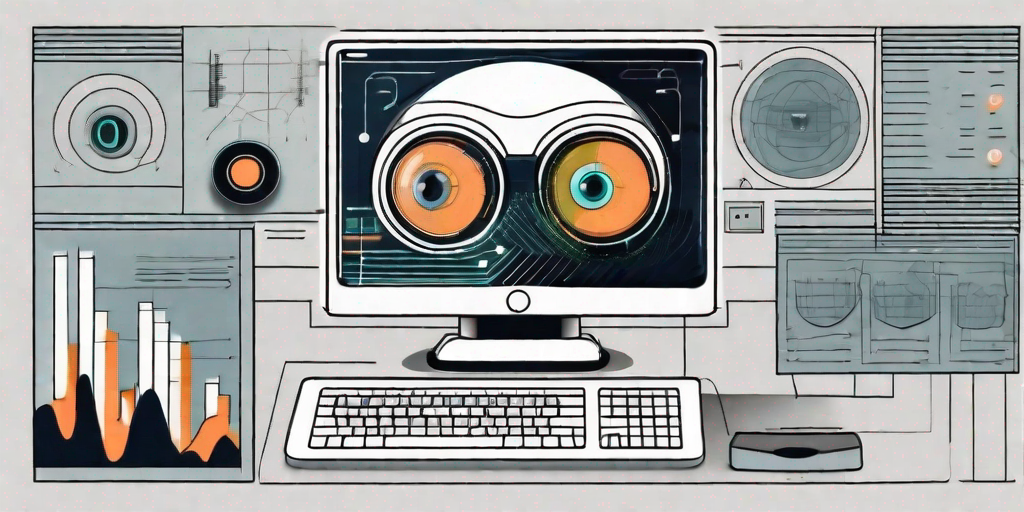An Innovation Futurist's Guide to Understanding Computer Vision

An Innovation Futurist's Guide to Understanding Computer Vision
Welcome to "An Innovation Futurist's Guide to Understanding Computer Vision!" In this article, we will explore the fascinating world of computer vision and its role in shaping technological advancements. As an innovation futurist, my goal is to provide you with a comprehensive understanding of this field and how it can influence our lives in ways we never imagined.
Understanding the Role of Computer Vision in Technological Advancements
Computer vision, at its core, is the ability of a machine to interpret and understand visual information. It enables computers to extract meaningful insights from images or videos and make informed decisions based on them. This technology has applications in various fields, such as healthcare, transportation, security, and entertainment.
Imagine a healthcare system that can automatically detect potential diseases from medical images, aiding doctors in making accurate diagnoses. With computer vision, medical professionals can rely on advanced algorithms to analyze X-rays, MRIs, and CT scans, identifying abnormalities that may not be immediately apparent to the human eye. This not only saves time but also improves the accuracy of diagnoses, leading to better patient outcomes.
In the field of transportation, computer vision plays a crucial role in the development of autonomous vehicles. Imagine a self-driving car that can identify and navigate through complex road situations. Computer vision algorithms can analyze real-time video feeds from multiple cameras mounted on the vehicle, detecting and tracking objects such as pedestrians, vehicles, and traffic signs. This enables the car to make informed decisions, such as adjusting its speed, changing lanes, or coming to a stop when necessary, ensuring the safety of both passengers and pedestrians.
Computer vision also has significant implications for security systems. With advanced surveillance cameras equipped with computer vision technology, it becomes possible to detect and track suspicious activities in real-time. These systems can identify individuals, recognize their behavior patterns, and alert security personnel in case of any potential threats. This enhances the overall security of public spaces, airports, and other critical infrastructure.
Moreover, computer vision has made significant contributions to the entertainment industry. From facial recognition in video games to augmented reality experiences, computer vision algorithms have the ability to create immersive and interactive digital environments. This technology allows users to interact with virtual objects and characters in a more natural and intuitive way, blurring the line between the real and virtual worlds.
As computer vision continues to advance, its potential applications are only limited by our imagination. From improving medical diagnostics to enhancing transportation systems, from bolstering security to transforming entertainment experiences, computer vision is revolutionizing our daily lives in ways we never thought possible.
The Impact of an Innovation Futurist on Computer Vision Interpretation
As an innovation futurist, my role is to interpret the potential impact of emerging technologies like computer vision. By studying trends and analyzing data, I can provide insights into how this technology is likely to evolve and shape our future. My fascination with computer vision lies in unlocking its capabilities and discovering new possibilities.
Computer vision, a field that combines artificial intelligence and image processing, has the potential to revolutionize various industries. From healthcare to transportation, the applications of computer vision are vast and diverse. By collaborating with researchers, engineers, and industry experts, I gain valuable insights into the latest advancements in computer vision.
One area where computer vision has made significant strides is in healthcare. With its ability to analyze medical images, computer vision can assist doctors in diagnosing diseases and identifying abnormalities. This technology has the potential to improve patient outcomes and revolutionize the way healthcare is delivered.
In the transportation industry, computer vision is being used to develop self-driving cars. By analyzing real-time data from cameras and sensors, these vehicles can navigate roads and make decisions without human intervention. This technology has the potential to reduce accidents and congestion, making transportation safer and more efficient.
Another exciting application of computer vision is in the field of retail. By analyzing customer behavior and preferences, computer vision can help retailers personalize the shopping experience. This technology can identify customer demographics, track their movements within a store, and provide targeted recommendations. By understanding customer preferences, retailers can optimize their inventory and improve customer satisfaction.
As an innovation futurist, I am constantly exploring the potential of computer vision and its impact on various industries. By staying up-to-date with the latest advancements and collaborating with experts, I can provide valuable insights and guide organizations in adopting innovative strategies.
By harnessing the full potential of computer vision, organizations can gain a competitive edge and drive growth. Whether it's improving healthcare outcomes, revolutionizing transportation, or enhancing the retail experience, computer vision has the power to transform industries and shape our future.
The Synergy of AI and Computer Vision
Artificial intelligence (AI) and computer vision go hand in hand. AI algorithms empower computer systems to understand and analyze visual data, enabling them to make intelligent decisions. This synergy has opened up a myriad of opportunities.
Imagine a world where robots can visually recognize and interact with objects in their environment, leading to more efficient and personalized interactions. For example, in the field of healthcare, AI-powered robots equipped with computer vision can assist doctors and nurses in diagnosing and treating patients. These robots can analyze medical images, such as X-rays and MRIs, with incredible accuracy, helping healthcare professionals make more informed decisions and provide better care.
AI-driven computer vision systems can also be used for quality control in manufacturing, detecting defects that human eyes might miss. In industries such as automotive and electronics, where precision and accuracy are crucial, AI algorithms can analyze visual data from production lines in real-time. By identifying even the smallest flaws or abnormalities, these systems can prevent defective products from reaching the market, saving both time and resources.
Moreover, the combination of AI and computer vision has revolutionized the field of autonomous vehicles. Self-driving cars rely heavily on computer vision to perceive and understand their surroundings. Through a network of cameras and sensors, these vehicles can detect and identify objects, such as pedestrians, traffic signs, and other vehicles, in real-time. AI algorithms then analyze this visual data to make decisions, such as when to accelerate, brake, or change lanes. This technology has the potential to greatly improve road safety and reduce accidents.
By combining AI and computer vision, we pave the way for a smarter and more connected future. The applications are not limited to robotics, healthcare, manufacturing, and autonomous vehicles. AI-powered computer vision systems can also be used in fields such as security and surveillance, agriculture, retail, and even entertainment. From facial recognition systems that enhance security measures to smart cameras that monitor crop health in agriculture, the possibilities are endless.
How an Innovation Futurist Predicts Future Trends in Computer Vision
Predicting future trends in computer vision requires a deep understanding of the technology and its potential applications. As an innovation futurist, I constantly monitor research papers, attend conferences, and engage with industry leaders to stay at the cutting edge.
I look for patterns and emerging techniques that push the boundaries of computer vision. By analyzing the current trajectory of the field and incorporating insights from multiple disciplines, I can make informed predictions about future breakthroughs and their impact on various industries.
One area that I closely follow is the development of advanced algorithms for object recognition. These algorithms are becoming increasingly sophisticated, enabling computers to identify and classify objects with greater accuracy and speed. This has significant implications for industries such as autonomous vehicles, where accurate object recognition is crucial for safe navigation.
Another exciting trend in computer vision is the integration of machine learning and deep neural networks. These technologies have revolutionized the field by enabling computers to learn from vast amounts of data and make intelligent decisions. By harnessing the power of machine learning, computer vision systems can become more adaptable and capable of handling complex tasks.
In addition to technological advancements, I also consider the societal and ethical implications of computer vision. For example, the widespread adoption of facial recognition technology raises concerns about privacy and surveillance. As an innovation futurist, it is important for me to not only predict the future of computer vision but also to advocate for responsible and ethical use of these technologies.
While predicting the future is not an exact science, combining data-driven analysis with creative thinking allows us to anticipate how computer vision will shape our world. By staying informed and actively engaging with the field, I strive to provide valuable insights and guidance to industries and organizations looking to leverage the power of computer vision in their operations.
Maximizing Opportunities with Computer Vision Technologies
Organizations across industries are waking up to the potential of computer vision technologies. To maximize the opportunities they offer, it is crucial to have a clear strategy in place.
Computer vision technologies have revolutionized various industries by enabling machines to interpret and understand visual information. From autonomous vehicles to facial recognition systems, computer vision has the power to transform the way we live and work. By harnessing the capabilities of computer vision, organizations can unlock new possibilities and gain a competitive edge in the market.
- Identify areas of application: Analyze your industry and identify areas where computer vision can make a significant impact. Whether it's automating processes, enhancing security, or improving customer experiences, understanding where to focus your efforts is key.
- Invest in talent and infrastructure: Building a capable team skilled in computer vision is crucial. Additionally, ensuring the right hardware and software infrastructure is in place will enable effective implementation of computer vision technologies.
- Continuously learn and adapt: Computer vision is an ever-evolving field, and staying updated is vital. Encourage a culture of continuous learning and experimentation within your organization to ensure you stay ahead of the curve.
When it comes to automating processes, computer vision can streamline operations by accurately identifying and classifying objects. For example, in manufacturing, computer vision can be used to inspect products for defects, reducing the need for manual inspection and improving overall efficiency. In the retail industry, computer vision can help automate inventory management by accurately tracking and counting products on shelves, minimizing stockouts and optimizing supply chain operations.
Enhancing security is another area where computer vision can play a crucial role. By leveraging facial recognition algorithms, organizations can strengthen access control systems, ensuring only authorized individuals are granted entry. Moreover, computer vision can be used for surveillance purposes, enabling real-time monitoring and detection of suspicious activities.
Improving customer experiences is yet another avenue where computer vision can make a significant impact. For instance, in the healthcare industry, computer vision can assist in the diagnosis of diseases by analyzing medical images such as X-rays and MRIs. In the entertainment sector, computer vision can enable personalized recommendations based on user preferences, enhancing the overall viewing experience.
Developing a skilled team of computer vision experts is essential for successful implementation. These professionals should have a deep understanding of computer vision algorithms, machine learning techniques, and data processing. By investing in talent, organizations can ensure the development of innovative solutions that leverage the full potential of computer vision technologies.
In addition to talent, having the right hardware and software infrastructure is vital. High-performance computing systems, GPUs, and specialized hardware accelerators can significantly enhance the speed and accuracy of computer vision algorithms. Furthermore, robust data storage and processing capabilities are necessary to handle the vast amounts of visual data generated by computer vision systems.
As computer vision technologies continue to advance, it is crucial for organizations to stay updated with the latest developments. Encouraging a culture of continuous learning and experimentation can help teams stay ahead of the curve and drive innovation. By attending conferences, workshops, and industry events, organizations can gain insights into emerging trends and best practices in computer vision.
Moreover, fostering collaboration with academic institutions and research organizations can provide access to cutting-edge research and talent. By actively participating in the computer vision community, organizations can contribute to the advancement of the field while benefiting from the collective knowledge and expertise.
Conclusion
In conclusion, understanding computer vision is essential for anyone interested in the future of technology. Its ability to interpret visual information has the potential to revolutionize numerous industries, from healthcare to transportation. As an innovation futurist, my aim is to guide organizations in harnessing the power of computer vision and leverage its opportunities effectively. By combining AI and computer vision, we pave the way for a smarter and more connected future. So, let's embrace this exciting technology and unlock its full potential together!
FAQs
1. What is computer vision and how does it work?
Computer vision is the ability of a machine to interpret and understand visual information. It enables computers to extract meaningful insights from images or videos and make informed decisions based on them. This technology uses advanced algorithms to analyze visual data and identify patterns or objects.
2. What are the applications of computer vision?
Computer vision has a wide range of applications in various fields. It can be used in healthcare to analyze medical images and assist in disease diagnosis. In transportation, computer vision is used in autonomous vehicles to detect and track objects for safe navigation. It also has applications in security systems for real-time surveillance and in the entertainment industry for creating immersive experiences.
3. How does an innovation futurist contribute to the understanding of computer vision?
An innovation futurist studies emerging technologies like computer vision and predicts their future impact. By analyzing trends, collaborating with experts, and staying updated with advancements, they provide valuable insights into the potential applications and implications of computer vision. Their role is to guide organizations in adopting innovative strategies and leveraging the power of computer vision effectively.
Contact a Innovation Futurist for your event
Are you intrigued by the potential of computer vision and its transformative power across various industries? Do you want to explore the synergies of AI and computer vision, or understand how to maximize opportunities with computer vision technologies? Then Dr Mark van Rijmenam, a renowned Innovation Futurist, is the speaker you need for your next event. With his comprehensive understanding and foresight in this field, Dr van Rijmenam will provide valuable insights, guide your organization in adopting innovative strategies, and help you anticipate how computer vision will shape the future. Don't miss this opportunity to engage with a leading expert in the field. Simply complete the form below and we will be in touch within 24 hours. Let's unlock the full potential of computer vision together!





